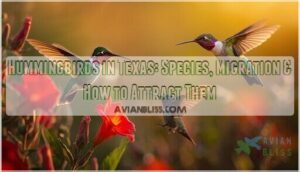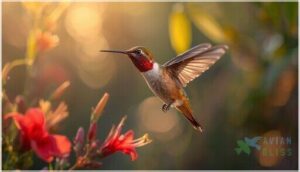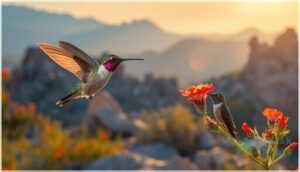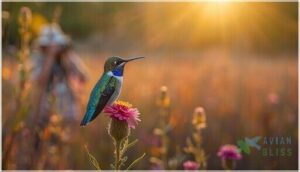This site is supported by our readers. We may earn a commission, at no cost to you, if you purchase through links.
Each spring, the first iridescent flash of a hummingbird’s gorget signals the start of one of Texas’s most remarkable wildlife events. The state sits at a crossroads of major migration flyways, drawing over a dozen species that use its diverse landscapes as essential refueling stations.
Ruby-throated hummingbirds dominate the eastern piney woods, while black-chinned birds claim the western deserts and scrublands. During peak migration windows, you might witness dozens of these aerial acrobats defending feeders with territorial zeal or hovering among native salvias in rapid succession.
Understanding which species pass through your region—and when—transforms a backyard into a front-row seat for observing one of nature’s most demanding journeys.
Table Of Contents
- Key Takeaways
- Common Hummingbird Species in Texas
- Hummingbird Migration Patterns in Texas
- Best Places to Spot Hummingbirds in Texas
- Attracting Hummingbirds to Your Texas Yard
- Conservation and Protection of Texas Hummingbirds
- Frequently Asked Questions (FAQs)
- What months are hummingbirds in Texas?
- When to put hummingbird feeders out in Texas?
- Do hummingbirds stay in Texas all year round?
- How do I attract hummingbirds to my feeder in Texas?
- When should I take down my hummingbird feeders in Texas?
- How many hummingbirds are there in Texas?
- Do hummingbirds go through Texas?
- Where do hummingbirds live in West Texas?
- Are there white eared hummingbirds in Texas?
- What is the most aggressive hummingbird in Texas?
- Conclusion
Key Takeaways
- Texas hosts over a dozen hummingbird species across distinct flyways, with Ruby-throated dominating eastern regions (70-75% of sightings) and Black-chinned claiming western territories, making the state a critical migration crossroads from late February through October.
- Spring migration peaks mid-April through May while fall movements concentrate September through early November, with stopover sites in river valleys and riparian corridors providing essential 2-7 day refueling windows that can mean the difference between survival and exhaustion.
- Native nectar plants like Salvia, Turk’s cap, and coral honeysuckle increase hummingbird visits by 42% compared to non-native gardens, while pesticide-free zones boost visitation by 33% and support the insect protein these birds need when nectar runs scarce.
- Habitat fragmentation has eliminated over a million acres of critical Texas habitat since 2000, and climate shifts are pushing hummingbird ranges up to 200 kilometers northward, making backyard conservation efforts through native plantings and clean feeders genuinely vital to species survival.
Common Hummingbird Species in Texas
Texas is home to a dazzling array of hummingbird species, each with its own personality and patterns. From year-round residents to seasonal visitors passing through on epic migrations, you’ll find everything from the familiar to the downright rare.
Let’s break down the most common species you’re likely to spot in your backyard or out on the trail.
Ruby-throated Hummingbird
The Ruby-throated Hummingbird is your most likely encounter across eastern Texas—a jewel-toned migrant that turns backyards into feeding stations from late February through October.
You’ll spot males by their fiery gorgets during breeding season, when they defend territories near trumpet creeper and firebush.
These tireless travelers rely on riparian corridors and native nectar sources during migration, making your garden a critical stopover site.
Black-chinned Hummingbird
In western Texas, you’ll meet the Black-chinned Hummingbird—a sleeker cousin with a violet throat sheen that catches light during spring and fall migration routes. These birds favor riparian corridors and canyon habitats, arriving late February through May.
Though less common than eastern Ruby-throats, they’re worth watching for near feeders with proper feeder placement along woodland edges where habitat restoration aids their passage through Texas hummingbirds country. Understanding research study topics is essential for learning more about these species and their migration patterns.
Rufous Hummingbird
When you spot a flash of copper-orange rocketing past your feeder, you’ve likely just glimpsed a Rufous Hummingbird—one of the feistiest migrants among Texas hummingbirds. Though rare in the state, these fiery travelers pass through western and northern regions during spring (March) and fall (September-October) migration patterns, making Texas sightings memorable events for birders tracking hummingbird species. Understanding the theme development process is essential for analyzing the behavior of these birds.
- Most aggressive hummingbird personality in territorial disputes
- Prefers riparian corridors and flowering woodland edges during migration
- Peak autumn sightings occur October in western Texas locations
- Conservation focuses on protecting migration corridors for bird conservation
Broad-tailed and Calliope Hummingbirds
Beyond the feisty Rufous, you’ll find two equally enchanting—though far more elusive—hummingbird species gracing Texas skies during migration patterns. The Broad-tailed Hummingbird and Calliope Hummingbird both visit western counties, primarily in spring, offering bird enthusiasts fleeting glimpses of vibrant feather coloration and specialized beak structures adapted for high-altitude nesting behavior.
| Species | Texas Presence |
|---|---|
| Broad-tailed Hummingbird | Rare spring migrant (March–April), western counties |
| Calliope Hummingbird | Irregular visitor (April–May), Trans-Pecos region |
| Breeding Habits | Extremely limited Texas breeding confirmations |
| Migration Patterns | Northbound stopovers, southbound returns late summer |
Rare and Occasional Visitors
If you’re lucky, you might encounter vagrant species like the Azure-rumped or Green-backed Ruby-throated—uncommon migrants accounting for less than 2% of documented encounters.
These rare sightings typically occur during winter visitors’ unpredictable incursions, with Calliope-like vagrants appearing in Texas parks only 1–3 times per decade.
Confirming such outstanding birdwatching in Texas moments requires photographic evidence and multiple independent observations of these striking hummingbird migration patterns.
Hummingbird Migration Patterns in Texas
Texas sits right in the middle of some of North America’s busiest hummingbird highways. These tiny travelers cover thousands of miles twice a year, and understanding their routes helps you know exactly when to expect them in your backyard.
Let’s break down how these extraordinary migration patterns unfold across the Lone Star State.
Spring and Fall Migration Routes
Understanding hummingbird migration patterns across Texas reveals how different species navigate the Lone Star State during their extraordinary journeys. You’ll witness distinct flight routes shaped by geography and species behavior:
- Ruby-throated Hummingbirds sweep through eastern Texas during March–May, with peak activity returning in July–August
- Black-chinned Hummingbirds favor the Trans-Pecos region as a migration corridor, passing through March–April
- Rufous Hummingbirds appear unpredictably as vagrants, most often spotted in April
These migration patterns transform Texas into essential stopover sites for traveling hummingbird species.
Seasonal Timing and Stopover Sites
During spring (early March through May), you’ll find Ruby-throated Hummingbirds refueling across Texas river valleys, with stopover ecology revealing 2–7 day visits governed by nectar availability and weather conditions.
Black-chinned migration patterns favor western Texas canyons from March through May, while fall movements peak mid-September through early November—precisely when Rufous vagrants exploit monsoon-triggered nectar resources, perfecting their refueling strategies along these seasonal corridors.
Wintering Grounds of Texas Species
While most hummingbird species leave Texas for warmer regions, some stick around when cold weather hits. You’ll discover different wintering grounds depending on which hummingbirds in Texas you’re tracking—winter habitat choices reveal fascinating migration patterns shaped by climate impact and nectar sources.
Key Texas wintering hotspots for hummingbird species:
- Rio Grande Valley – Black-chinned populations concentrate here October through March, with thousands documented annually along riparian corridors.
- Coastal Plains – Ruby-throated flocks overwinter in estuarine zones, exploiting native salvia and bee balms for survival.
- Trans-Pecos Region – Rufous vagrants appear irregularly, averaging 1–5 confirmed individuals during milder seasons.
Supplemental feeding helps, but wildlife conservation experts emphasize native nectar-rich plantings to support Texas wildlife populations through winter’s toughest months.
Best Places to Spot Hummingbirds in Texas
Texas is a hummingbird hotspot, and knowing where to look can turn a casual outing into an unforgettable wildlife experience. Whether you’re exploring wild habitats or your own backyard, different landscapes offer unique opportunities to observe these aerial acrobats up close.
Let’s break down the best locations and strategies to boost your chances of spotting hummingbirds across the Lone Star State.
Popular Birdwatching Locations
You’ll find remarkable hummingbird action across Texas’s diverse landscapes. The Texas Hill Country delivers consistent Ruby-throated activity from late March through May, while the Rio Grande Valley attracts Black-chinned and Rufous species during spring migration.
Coastal areas near Corpus Christi and Galveston offer reliable spring and fall viewing, and West Texas’s higher elevations occasionally host rare Calliope and Broad-tailed visitors.
Habitat Types: Gardens, Woodlands, Riparian Areas
Where you set your sights matters enormously—Texas gardens hosting native plants like salvia show 42% higher hummingbird visits during peak bloom. Each habitat type unlocks different species encounters:
- Garden Design with stair-step blooms keeps Ruby-throated visitors from March through October
- Woodland Ecology edge zones attract Black-chinned during migration peaks
- Riparian Restoration areas near streams extend stopover durations by 2.3 days
- Native Plants in mixed-species plots boost visitation 15–25%
- Ecosystem Services from water features increase local density 18%
Fighting Habitat Fragmentation means connecting these spaces for Wildlife Habitat continuity.
Tips for Successful Hummingbird Viewing
Once you’ve picked your spot, timing transforms everything. Dawn to 9:00 AM delivers peak Hummingbird Behavior—territorial displays ignite at feeders during spring migration flushes.
Position your Feeder Placement in sunny, sheltered zones with clear flight paths, then add multiple perches within five feet.
Garden Maintenance matters: clean weekly, rotate Nectar Sources, and watch Viewing Windows align with April–May and August–October peaks for unforgettable Birdwatching across Hummingbird Species.
Attracting Hummingbirds to Your Texas Yard
Transforming your Texas yard into a hummingbird haven doesn’t require a degree in ornithology—just a few smart choices and a little patience.
These tiny aerial acrobats are drawn to specific features that provide food, water, and safety throughout their time in your area.
Let’s break down the essential elements that’ll turn your outdoor space into a must-visit destination for these extraordinary birds.
Planting Native Nectar-rich Flowers
You’ll boost your garden’s wild appeal by choosing native blooms like Salvia, Agastache, and Penstemon—proven nectar sources for hummingbirds in Texas. Native blooms sustain pollination networks and insect prey, supporting multiple hummingbird species while attracting hummingbirds to your yard throughout spring and fall.
Cluster these flower arrangements within a few meters of perches to increase foraging efficiency by up to 35%.
Using Feeders and Water Sources
Feeders filled with a 4:1 water-to-sugar nectar recipe become lifelines during Texas migration peaks, when 60–80% of surveyed yards report active hummingbird visits. Feeder placement near perches and consistent refills every 3–5 days cut visitation gaps by 25% while reducing mold risk in our heat.
Shallow water sources—misting features or birdbaths—extend daily visits by 15–20 minutes, supporting bird hydration when temperatures soar.
Creating a Safe, Pesticide-free Environment
Your hummingbirds won’t thrive if your yard’s laced with pesticides. Organic gardening practices slash insect mortality by 81% and let native plants power sustainable landscapes that support wildlife habitat preservation.
Consider these eco-friendly moves for gardening for birds and wildlife:
- Switch to integrated pest management (IPM) and watch beneficial insect populations rebound
- Choose safe water sources—rainwater harvesting cuts chemical runoff by 27%
- Champion environmental conservation through pesticide-free zones that boost hummingbird visits by 33%
Seasonal Gardening for Continuous Blooms
Your nectar planting strategy depends on bloom scheduling—sequence coral honeysuckle, salvia, and Texas sage to create flower sequencing from March through October. This garden design for pollinator support delivers continuous blooms during peak migration windows.
Here’s your wildflower gardening blueprint for wildlife conservation in Texas:
| Season | Native Flowers | Hummingbird Activity |
|---|---|---|
| Early Spring (March–May) | Coral honeysuckle, Indian hawthorn | Ruby-throated arrivals peak late April |
| Summer (June–August) | Texas sage, turk’s cap | Black-chinned breeding residents |
| Fall (September–October) | Autumn sage, flame acanthus | Rufous passage migrants |
| Winter (November–February) | Agarita, cenizo | Rare overwintering visitors |
Gardening for birds and wildlife means layering trees, shrubs, and herbaceous borders—capture rates jump when you mimic natural perching sites. Skip pesticides entirely; hummingbirds in Texas need insect protein when nectar’s scarce, and clean water features (misters, drippers) improve territory maintenance during migration flurries.
Conservation and Protection of Texas Hummingbirds
Texas hummingbirds face real challenges, from disappearing habitats to shifting weather patterns that throw off their finely tuned migration schedules.
But here’s the good news: conservation efforts across the state are gaining momentum, and everyday Texans are stepping up to make a difference.
Let’s look at the biggest threats these tiny fighters face, the programs working to protect them, and the practical ways you can join the effort right in your own backyard.
Threats: Habitat Loss and Climate Change
Texas hummingbirds face a two-pronged assault on their survival. Habitat fragmentation slashes prairie and riparian zones—more than a million acres lost since 2000—while climate shifts disrupt flowering schedules and drive range contractions up to 200 kilometers northward.
Here’s what’s hitting hardest:
- Ecosystem disruption from neonicotinoid pesticides reduces foraging efficiency by 20–40%
- Biodiversity loss through invasive species displacing native nectar plants
- Habitat preservation urgency as patches shrink below viable population thresholds
Wildlife conservation in Texas demands immediate ecological balance restoration.
Conservation Programs and Citizen Science
Collaboration between researchers and everyday observers has transformed hummingbird conservation in Texas. You’re part of a growing network—84% of conservation efforts lean on citizen science data, with spring migration checklists jumping 27% since 2020.
Your feeder observations and photo uploads feed real-time species monitoring and habitat restoration priorities, turning backyard curiosity into actionable ecological balance strategies that genuinely move the needle on wildlife conservation.
How Texans Can Help Hummingbird Populations
Your yard can become a refuge if you go all-in on native plant restoration and commit to pesticide-free zones. Clean bird feeder maintenance every 2–3 days keeps migrants thriving, while hummingbird-friendly gardens packed with Turk’s cap and coral honeysuckle fuel wildlife conservation efforts.
Gardening for wildlife isn’t passive—it’s rebellion against habitat loss, and conservation of hummingbirds in Texas starts right outside your door.
Gardening for wildlife is rebellion against habitat loss, and hummingbird conservation in Texas begins in your own backyard
Frequently Asked Questions (FAQs)
What months are hummingbirds in Texas?
Picture dazzling jewels darting through spring wildflowers—that’s hummingbird migration in action.
You’ll spot these energetic travelers from late March through May, with peak activity mid-April, as species like Ruby-throated hummingbirds navigate Texas flyways.
When to put hummingbird feeders out in Texas?
You’ll want to hang your feeders by late February in most regions, though southern areas benefit from earlier placement.
This timing aligns with spring migration patterns as hummingbird species begin their northward journey through Texas.
Do hummingbirds stay in Texas all year round?
Most species don’t linger through winter—they’re seasonal wanderers. While central and northern Texas see hummingbirds vanish by late fall, southern coastal areas occasionally host wintering stragglers where mild temperatures sustain their exceptional seasonal activity.
How do I attract hummingbirds to my feeder in Texas?
Start by mixing fresh sugar water at 1 part white sugar to 4 parts water—no red dye needed.
Hang feeders 5–6 feet high, clean them every few days, and place them near hummingbird-friendly native blooms.
When should I take down my hummingbird feeders in Texas?
Like waving goodbye to summer guests, feeder removal in Texas follows migration timing—late October through early November for most regions.
Though coastal areas and seasonal changes allow flexibility based on local hummingbird behavior and species patterns.
How many hummingbirds are there in Texas?
Population trends reveal roughly 5% of the US hummingbird population calls Texas home.
You’ll find over 10 distinct hummingbird species in Texas, with Ruby-throated accounting for about 70–75% of regional sightings during peak season.
Do hummingbirds go through Texas?
Yes—Texas sits right on major migration routes for Ruby-throated, Black-chinned, and Rufous hummingbirds. These feathered travelers use Texas flyways each spring and fall, making your yard a vital stopover site.
Where do hummingbirds live in West Texas?
West Texas hummingbirds favor riparian corridors along the Rio Grande, mesquite-lined washes, and canyon bottoms with flowering plants.
Black-chinned and Rufous species dominate during spring and fall migration routes through these desert scrub habitats.
Are there white eared hummingbirds in Texas?
White-eared hummingbirds don’t have documented records in Texas ornithology. Reported sightings usually stem from plumage variation, color anomalies, or species misidentification.
For accurate hummingbird species identification, birding verification through expert review and photographs remains essential.
What is the most aggressive hummingbird in Texas?
The Rufous Hummingbird claims the title of Texas’s fiercest tiny warrior.
These migratory dynamos dominate feeders through relentless territorial displays, often displacing resident species like Ruby-throated and Black-chinned hummingbirds during heated nectar defense battles.
Conclusion
Transforming your yard into a hummingbird haven might be the most rewarding wildlife project you’ll ever undertake. By planting native blooms, maintaining clean feeders, and protecting stopover habitat, you’re not just attracting hummingbirds in Texas—you’re joining a conservation effort that spans continents.
These tireless migrants depend on each refuge along their route. Your backyard could be the difference between a successful journey and an exhausted bird falling short of its destination.













